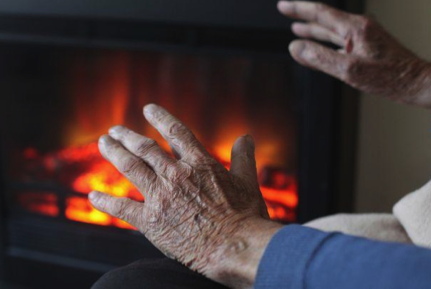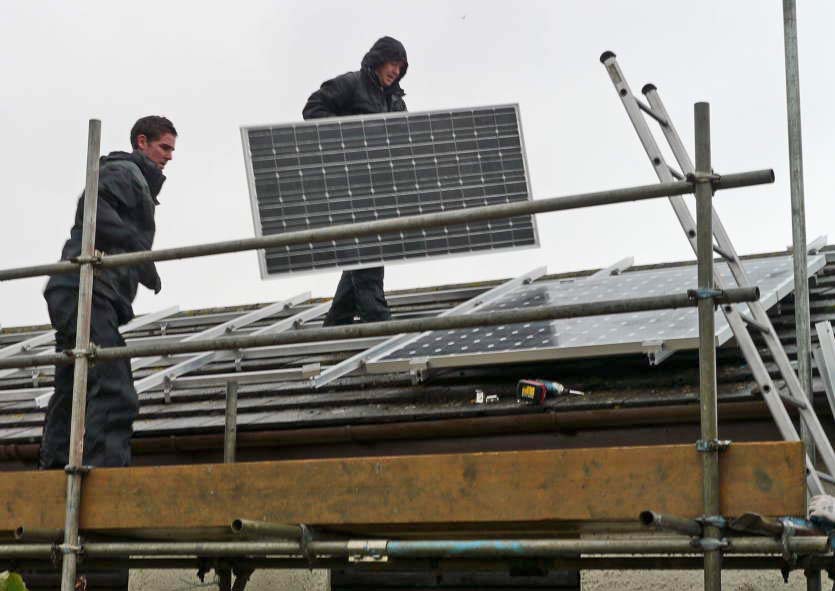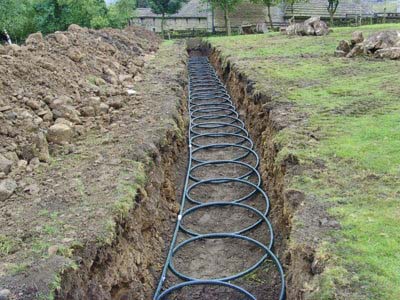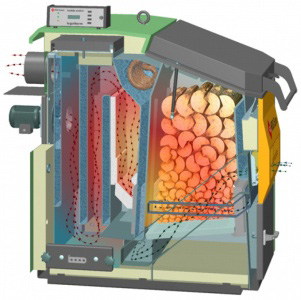
Updated 24 May 2017

|
Updated 24 May 2017 |
|
HOME PAGES GLOBAL WARMING WHAT YOU CAN DO GREEN ISSUES BACKGROUND THE INITIATIVE |
Financial Support for Insulation and Domestic Renewables This page summarises various schemes to help make insulating your house and installing efficient, renewable energy sources for heating more affordable.
The Green Deal has been terminated for new applicants so information concerning it has been deleted. News The government is still supporting the Renewable Heat Incentive (RHI) to encourage solar hot water, heat pumps, and biomass sources of heating. After some delays the first phase, for large-scale systems, started in November 2011. For domestic users the scheme finally started up in April 2014. The scheme covers solar hot-water panels, ground-source and air-source heat pumps, and biomass boilers. See below for up-to-date information on the RHI. The government’s Green Deal, the centre-piece of its programme to upgrade the energy efficiency of the UK’s housing, had extremely poor take-up and was widely regarded as misconceived and complex. In July 2015 it was terminated for new appiicants. The government introduced Feed-in Tariffs in April 2010. This encourages installation of renewable technologies: solar photovoltaic panels, small wind turbines, small-scale hydro, etc. However, there have been major reductions and new restrictions in the Feed-in Tariff for solar photovoltaic systems. See below for up-to-date information. Grants for Insulation and Energy Improvements 
Insulating your home, which is often a simple matter of loft and/or cavity wall insulation (photo at right) and draught-proofing, is the most effective way to save energy and reduce your bills. (Photo at right shows installation of cavity-wall insulation.) These can also reduce condensation and mould. Other measures include installing an energy-efficient condensing boiler, jackets for hot water cylinders, insulating pipes, using reflective radiator panels, installing individual thermostatic radiator valves and installing double glazing. However, the system of grants for free or inexpensive installation of cavity-wall and loft insulation that was funded by the energy companies finished at the end of 2012. The Warm Front scheme for people on benefits ended as well. The main programme of financial aid for the future was supposed to be the government’s Green Deal, which started in January 2013. Based on loans (at relatively high interest) tied to the property and paid back via electricity bills, it was widely regarded as being over-complex and misconceived. Take-up was abysmal, and it was terminated for new applicants in July 2015. No replacement has been promised, despite the huge number of older, poorly insulated houses in the UK. For people who are older, have low incomes or are otherwise vulnerable there are schemes to help with fuel bills and make improvements. These are described below, along with information about new obligations for landlords of privately rented accommodation concerning energy efficiency. The Warm Home Discount scheme For winter 2016–17, vulnerable
people (e.g. older or low income) could get a one-off £140 discount on
their electricity bill from energy suppliers. It is not yet known if it will
continue for next winter. Ask your energy supplier, or go to: The Affordable Warmth Obligation This is part of the Energy Company Obligation (ECO). It
exists to provide heating and insulation improvements (cavity-wall and loft
insulation, and replacement boilers) for low-income and vulnerable households,
not including those in social housing. There are complex eligibility criteria
for this means-tested scheme. Call the Energy Saving Advice Service on 0300 123 1234
to check whether you might be eligible, and to apply if you are. There is more
information at: Oxfordshire Affordable Warmth Network If you are having trouble paying
your energy bills, ring the Affordable Warmth Network on 0800 107 00 44.
There is more information at: Cold weather payments If you’re getting certain benefits,
you may be eligible for these when your local temperature is either recorded
as, or forecast to be, an average of 0 °C or colder for at least seven
consecutive days. There is a payment of £25 for each seven-day period
of very cold weather between 1 November and 31 March. (These payments
are not the same as the Winter Fuel Payments.) You can check if your area is
due a payment at: 
Getting your private sector landlord to make energy improvements Many energy improvements are the landlord’s responsibility so you will need to ask your landlord to do them, or get their written permission to do them yourself. The first step is to talk amicably to him/her. Landlords will not benefit financially from lower energy bills, and so may be reluctant to make improvements. But you can also alert your landlord to their existing and future legal responsibilities, and mention that energy efficiency improvements usually help preserve the fabric of the property. There is a useful leaflet (pdf) from Oxford City Council with energy saving advice for private-rental tenants. Local Authorities have a duty to take action against landlords under the Housing Act 2004 if the condition of a property affects the health of the most vulnerable occupier. Issues relating to household energy efficiency include excess cold, damp and mould, excess heat, carbon monoxide, uncombusted fuel gas from faulty appliances and faulty appliance wiring. If a landlord fails to give permission to have grant-funded energy efficiency measures installed, tenants can complain to the Environmental Health Department of their local authority. If landlords do not comply, they can be prosecuted and the local authority can carry out the repair work itself.You can telephone Environmental Health in the Vale of White Horse on 01235 540 555, or email env.health@whitehorsedc.gov.uk. Financial Support for Renewable Generation This section covers the UK’s provisions for supporting domestic (i.e. small-scale) renewable energy generation: the Feed-in Tariff begun in April 2010 to pay for electricity generation, and the (long delayed) Renewable Heat Incentive to help pay for producing heat and hot water, which started in April 2014. More detailed information may be found on the Department of Business, Energy and Industrial Strategy (BEIS), Energy Saving Trust, and OFGEM websites. The Feed-in Tariff aims to increase small-scale electricity generation in the UK. It has already shown that by expanding the market, expensive technologies such as solar photovoltaic panels have become cheaper. The scheme, which started in April 2010 and will run for at least 20 years (25 for some solar photovoltaics), covers a range of technologies. What makes the FIT unusual, compared to schemes in other countries, is that it rewards all generation, not just what is exported to the grid. The reasoning behind this is that electricity used locally does replace energy from the grid, and is efficient because it reduces losses in transmission. It also makes consumers more aware of how they use their energy and so, hopefully, leads to lower consumption. The FIT replaced the up-front grants from the Low Carbon Buildings Programme. The Renewable Obligations programme, which is primarily aimed at large-scale generation, no longer covers domestic systems. Systems installed before July 2009 were transferred to the FIT, but receive a uniform low tariff because the FIT aims to encourage new systems, not reward existing ones. 
General points The electricity generating technologies covered are:
The tariffs differ between different technologies, and for different-size systems – they are higher per kilowatt-hour (kWh) for smaller systems. The tariff for a particular system is fixed at the time of installation and then is indexed for inflation. However, as time goes on and the cost of the systems (hopefully) decreases, the tariffs for new installations will be reduced – this is called ‘degression’. There are periodic reviews of the operation of the scheme and the tariffs being paid. Payments are tax free. The Energy Saving Trust has a simple calculator to allow you to estimate how much you would get under the Feed-in Tariff. Both the system components and the installer must be approved under the Microgeneration Certification Scheme. In its original form, other measures to reduce energy consumption (insulation, heating controls, lighting) were not a requirement for receiving the FIT. However, since April 2012 properties installing solar PV must have Energy Performance Certificate (EPC) ratings of at least D in order to get the full tariff; otherwise they will get much less. However, this requirement does not apply to other technologies. The register of installed systems is held by OFGEM. Payment is made by electricity suppliers and comes from them, not from the government.
A condensed table of Feed-in Tariffs for domestic-scale solar photovoltaic installations follows. These rates, for 2017–18, include annual inflation indexing. Exports to the grid from older systems get an extra 3.57p per kWh, while systems registered from late 2012 (marked with a *) get a higher rate of 5.03p per kWh. Systems on output boundaries will get the higher rate. A table with full details of all supported technologies, including larger systems, may be found here.
Feed-in Tariff developments and current status The FIT scheme for solar PV was very successful initially, with many more installations than predicted. This was because the tariff had been set quite generously, combined with falling costs for solar panels. The governmentresponded with a series of reviews to reduce the payments – these were held earlier than had been promised. 
The first review concerned very large PV systems of over 50 kW. Many of these were being installed on community buildings such as schools and village halls. However, because the FIT gave a good return on investment, some companies had been installing very large systems for profit, often on farmland. In March 2011 the government announced an immediate, huge reduction in the FIT for new large systems, e.g. systems from 250 kW–5000 kW reduced from 30.7p per kWh to 8.5p per kWh. The government said that this was to stop these large systems getting a disproportionate share of the FIT funding. However, the cut was so big that it discouraged almost all plans to build such big systems, including many community projects. The solar PV industry said that such a big change without warning made it impossible to plan for the future or to obtain loans to finance expansion. During 2011, the cost of PV systems fell and people also anticipated the reductions in the tariff that had been scheduled for April 2012. This produced a surge in new systems. On 31 October 2011, without warning, the government launched an early review of FITs for domestic systems. They claimed that the large number of installations was going to cost too much over their 25-year lifetime and that reduced prices meant returns on investment were much higher than expected. It was proposed to cut the tariff for new systems (but not existing ones) by more than half, and make other drastic changes such as requiring properties to achieve an energy performance rating of at least C. The lower rate was to apply to properties registered from mid-December 2011, before the consultation had even closed. the government were taken to court and the retrospective date was ruled illegal; a series of appeals were all turned down but caused nearly five months of chaos and confusion for consumers and for the solar PV industry. The result was to delay the effective date of the new, much lower tariff (21p per kWh) to March 2012. In addition, properties registered from April 2012 are required to have an energy efficiency rating of at least D. (The original proposal was to require a rating of C. This would have excluded a huge number of houses, especially older ones. There's a brief explanation of the rating system here.) However, even before these measures took effect, the government launched another consultation proposing major changes to the future operation of the solar PV tariff. The result was an even lower tariff for new domestic systems of 16p per kWh starting in August 2012, with continuing reviews (aimed at reducing the tariff further, and based on sales of PV systems) every three months – the higher the sales the bigger the reduction. If the energy efficiency requirement of D is not met these sytems get a much lower rate. In addition, the lifetime of the tariff for these systems was reduced from 25 years to 20 years. On the other hand, the export tariff for these new systems was raised. Installations of more than 25 systems (e.g. community schemes) will get 90% of the full tariff rather than the 80% introduced in the first review. In parallel, another review looked at the FIT for other types of electricity generation. Unlike solar PV, the other technologies have had fewer systems installed than predicted, and the proposed changes in the level of the tariffs are not drastic. Reviews for these technologies now take place once per year. A scan of our table shows how the tariffs have been steadily reduced, and by more than the decrease in system costs, since FiTs began. In autumn 2015, the government announced yet another review of the solar PV tariff, justifying it by saying that the number of installed systems already exceeded the target for 2020. The proposed reduction was 87% (!), and solar installation companies began to go bankrupt with many job losses. In December the proposed cut was reduced to 65%, with the additional proviso that the budget for new systems would be capped each quarter. Support for solar farms of all sizes was completely eliminated. * The complexity of the FIT situation means that it is extremely difficult to check that FIT payments are correct. It is necessary to know the date the system was registered, and for newer systems the EPC rating of the property. On top of that, indexation means that the tariffs change every year. The initially generous Feed-in Tariff terms led a number of firms, including British Gas, to make what sounded like an attractive offer. They offered to install solar panels on your roof free of charge, and any of the generated electricity used in the homel saves the cost normally paid to the electricity supplier. This type of offer is not as good as it sounds:
To estimate how much you might get from your own panels under the Feed-in Tariff, use the Energy Saving Trust's calculator. The effect of drastic Feed-in Tariff reductions in the past few years on rent-a-roof schemes has been that they have almost disappeared. * Although we welcome the use of renewable energy wherever possible, we believe that if you can manage to pay for solar panels yourself, or even if you can borrow the money at a low interest rate, then you would be better off buying the panels yourself and benefiting from the full Feed-in Tariff, which provides an index-linked and tax-free income for 20 years. Renewable Heat Incentive (RHI) The Renewable Heat Initiative (RHI) is aimed at a range of technologies and systems, small and large, and is for individual owners and landlords in both private and social housing as well as community groups and businesses of all sizes. The short-term target is for 15% of all UK energy consumption (almost half of which is for heating) to be from renewable sources by 2020. The RHI will try to help with that by making renewable heating a reasonable investment. Other goals include lowering the prices for renewable systems by expanding their markets, and increasing the UK’s energy security by reducing dependence on imported fossil fuels. Here we will cover the small-scale, domestic proposals of the RHI. The RHI for large-scale systems started up in November 2011. However, take-up has been lower than predicted. For domestic users, start-up was first delayed to October 2012, delayed again to summer 2013, and finally started in April 2014. However, due to the delays, ‘legacy’ systems installed from 15 July 2009 onwards were eligible for the RHI payments. The RHI is said to be a world first. This means that, unlike the Feed-in Tariff, there were no models elsewhere from which to gain experience, and is part of the reason for the delays and subsequent changes. In addition, the money for the scheme is going to come from government funds (unlike the Feed-in Tariff) and so is limited by the cuts in public funding. 
With the exception of solar thermal panels, which are treated as a special case, the main thrust of the scheme concerns domestic central-heating boiler replacements. The tariffs are therefore aimed at reimbursing the extra cost of renewable technologies compared to buying a replacement boiler. The scheme is available for all homes, both on and off the gas grid. However, homes not on the gas grid and using oil, coal and electric heating will benefit more from switching to renewables because they have higher heating bills. Oil and coal also have higher carbon emissions than gas. So although available to all, the RHI is mainly targeted at homes that are not on the gas grid. The initial aim is to support around 750,000 renewable heating systems through the domestic RHI by 2020. As an interim measure while the RHI was delayed, Renewable Heat Premium Payments were provided until March 2014. Most people who received Renewable Heat Premium Payments are eligible for RHI support. Domestic technologies covered The heat-producing technologies that are covered by the Renewable Heat Incentive for domestic installations are:
Other technologies that might have been included but are not include air-to-air heat pumps, geothermal energy, renewable combined heat and power, biogas and bioliquids. (Some of these are more appropriate for large-scale use.) Only one of the ‘boiler-replacement’ technologies may be installed in a property, but it is permitted to also install solar thermal panels and receive the tariffs for both systems. General information The small-scale RHI covers single domestic dwellings, and is open to owner-occupiers, private landlords, providers of social housing, third-party owners of heating systems and self-builders. It will not be open to new build properties other than self-build. There is more information on the scheme at www.ofgem.gov.uk/domestic-rhi. Both the system and the installer must be approved under the Microgeneration Certification Scheme. The RHI will be administered by OFGEM. Before applying for RHI support, all applicants, including those with eligible systems installed since July 2009, will need to have a recent Energy Performance Certificate for the property. Loft insulation (to 250mm) and cavity-wall insulation must be installed where these measures are recommended by the assessment. If the the required loft and cavity-wall insulation are yet to be installed, an updated Energy Performance Certificate (EPC) must obtained as proof of installation (or valid evidence provided to show why installation was not feasible). In order to minimise air pollution, new biomass systems must comply with limits on harmful particulate and nitrogen oxides emissions. Legacy biomass installations (installed between July 2009 and spring 2014) will not have to meet these requirements. RHI biomass recipients will have to make an annual declaration that they are using only approved fuel from a supplier registered on an approved supplier list (not yet set up, but promised for April 2014), and keep receipts as evidence for future audits.
The tariffs below will be paid quarterly for seven years.

For solar thermal systems the renewable heat generated will be based on an estimate of system performance, done as part of a Microgeneration Certification Scheme installation. A typical system might produce 1200–1500 kilowatt-hours of energy per year. For biomass the renewable heat generated will be based on an estimate of heat demand from an Energy Performance Certificate (EPC). A small house might use roughly 12,000 kilowatt-hours per year for heating while a large one might use 20,000 kilowatt-hours. For heat pumps the renewable heat generated will be based on an estimate of the heat demand from an EPC combined with an estimate of the heat pump’s efficiency. A medium-size house with an air-source heat pump might use heat energy of 15,000 kilowatt-hours per year. Note that only heat pumps with a Seasonal Performance Factor (SPF) of 2.5 and above are considered renewable in the EU and eligible for the RHI. From April 2017 heat pumps must have their electricity usage metered in order to check performance. Tariff details As with the Feed-in Tariff, RHI tariffs will change annually in line with the CPI inflation index. There is also a system of ‘degression’ to control the costs of the RHI by periodically reducing the tariffs for new applications to the scheme – this does not apply to those already receiving payments. Heat metering To help improve performance of renewable heating systems, there will be an extra incentive of £230 per year for heat pumps and £200 per year for biomass boilers for applicants who install metering and monitoring packages. For houses that have a back-up heating system such as an oil boiler, and for second homes, metering systems will be required. |
 |
If you have any comments or queries about this website please contact the
webmaster. |
© Blewbury Energy Initiative 2017 |